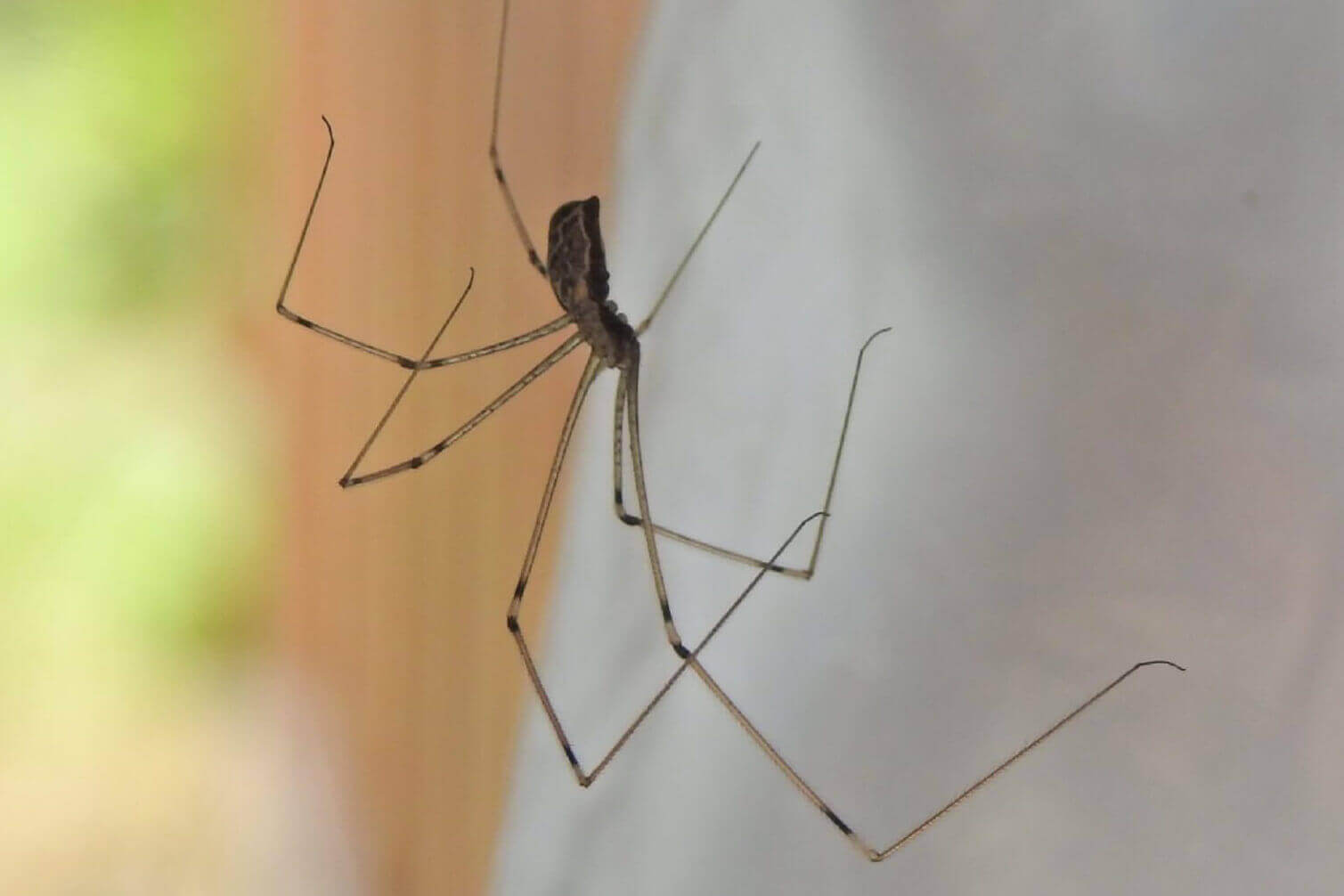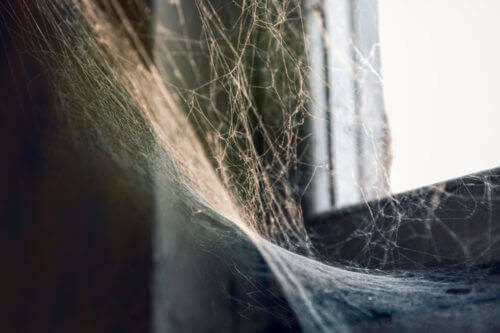Cellar Spider Facts & Information
Everything you need to know about cellar spiders
What Do Cellar Spiders Look Like

All cellar spiders have oval-shaped bodies that range in color from pale yellowish to light brown or gray. Adult female long-bodied cellar spiders have a body length of about ¼-5/16” with front legs about 1 ¾-1 15/16” long. Adult male long-bodied cellar spiders have a body length of about ¼”.
Like all arachnids, cellar spiders have eight legs; however, theirs are very elongated and thin compared to other spiders. Cellar spiders also have eight eyes that are arranged into two widely spaced lateral groups of three each and two eyes in between. They have a cylindrical abdomen that is about three times longer than it is wide. Long-bodied cellar spiders are also similar in appearance to harvestmen – which are arachnids, but technically not spiders – given their equally noticeable, lengthier legs. As such, the “daddy longlegs” nickname also applies to harvestmen, but, by contrast, these arachnids have oval bodies that are more reddish in color compared to cellar spiders. Any spider in your house means their food is there. So, you can have a spider exterminator come in to help, but that pest control company should be taking care of the other pests as well.Not the spider you have?
Like all arachnids, cellar spiders have eight legs; however, theirs are very elongated and thin compared to other spiders. Cellar spiders also have eight eyes that are arranged into two widely spaced lateral groups of three each and two eyes in between. They have a cylindrical abdomen that is about three times longer than it is wide. Long-bodied cellar spiders are also similar in appearance to harvestmen – which are arachnids, but technically not spiders – given their equally noticeable, lengthier legs. As such, the “daddy longlegs” nickname also applies to harvestmen, but, by contrast, these arachnids have oval bodies that are more reddish in color compared to cellar spiders. Any spider in your house means their food is there. So, you can have a spider exterminator come in to help, but that pest control company should be taking care of the other pests as well.Not the spider you have?
How Did I Get Cellar Spiders
Cellar spiders construct loose, irregular webs in areas with higher relative humidity and moisture, such as homes, sheds, barns, and warehouses. Within these structures, cellar spider webs are usually found in dark and damp places, including but not limited to the corners of eaves, windows and ceilings in cellars, basements, crawlspaces, and garages. They can hitch a ride in on you, a package, even in groceries so how you got them could be a mystery but not surprising.
Female long-bodied cellar spiders may produce up to three egg sacs each containing 13-60 eggs throughout the course of their life. The sacs are created from a thin layer of silk that is see-through. The cluster of eggs gives the sac the appearance of an unripe blackberry. The females then carry the egg sacs around with them in their mouths until the eggs hatch, as opposed to resting them in their web like other spider species do. The emerging spiderlings often cling to their mother for a short time. There are five molts before the spiderlings reach full maturity – a process that takes one full year. Adult cellar spiders usually live for about two years.
Female long-bodied cellar spiders may produce up to three egg sacs each containing 13-60 eggs throughout the course of their life. The sacs are created from a thin layer of silk that is see-through. The cluster of eggs gives the sac the appearance of an unripe blackberry. The females then carry the egg sacs around with them in their mouths until the eggs hatch, as opposed to resting them in their web like other spider species do. The emerging spiderlings often cling to their mother for a short time. There are five molts before the spiderlings reach full maturity – a process that takes one full year. Adult cellar spiders usually live for about two years.

Cellar spiders prefer to hang upside down in their webs as they wait for prey, which typically consists of other spiders and insects. When bothered, a cellar spider will repeatedly pulse its body to make its entire web shake. These pulsations help to entrap any insects that have approached the web and become the spider’s next meal.
Unlike species that expend their webs and then make new ones, or clean their webs to reuse them, cellar spiders will continue to layer additional, new webs on top of their old ones. As a result, the webs can build up in excessive volume in a somewhat short period of time, creating a noticeable cobweb appearance in the home or building.
Unlike species that expend their webs and then make new ones, or clean their webs to reuse them, cellar spiders will continue to layer additional, new webs on top of their old ones. As a result, the webs can build up in excessive volume in a somewhat short period of time, creating a noticeable cobweb appearance in the home or building.
Problems Caused by Cellar Spiders
Spiders – no matter what species – get a bad rap for just being scary looking. In addition, their webs may be out of reach of your broom, making for an unkempt look in your business or home. All spiders are integral in keeping many different pest populations in check – even some spider species! They rarely bother humans and are more afraid of you than you are (or should be) of them. That doesn’t mean you want them in the break room or the house with you! If you do have spiders and spider webs, it is an indication that there are other pests (their food) in your home or business. Spider treatments can help but make sure you bring in an expert that will not just help with spider control but with the insects that are attracting the spiders in.
How Do I Get Rid of Cellar Spiders
To keep cellar spiders from entering your home in the first place, seal cracks around the foundation of your home with a silicone-based caulk. Consider using yellow light bulbs for exterior lighting, as that may reduce the number of cellar spiders and other insects that are typically attracted to white-light sources. Additionally, it’s good practice to consider using a dehumidifier in basements, cellars and crawl spaces, since cellar spiders thrive in moisture.
Be sure to store firewood at least twenty feet from the home on a raised structure to deter spiders – and plenty of other pests – from hiding out in the wood. Make sure to wear gloves when moving the wood, and inspect it carefully before bringing any indoors.
Inside, keep clothes and shoes from piling up on the floor and shake them out before putting them on. Also, consider using tightly sealed plastic boxes to store seldom-used items like boots, baseball mitts, skates, etc. in the basement, garage, or other dark areas.
Be sure to store firewood at least twenty feet from the home on a raised structure to deter spiders – and plenty of other pests – from hiding out in the wood. Make sure to wear gloves when moving the wood, and inspect it carefully before bringing any indoors.
Inside, keep clothes and shoes from piling up on the floor and shake them out before putting them on. Also, consider using tightly sealed plastic boxes to store seldom-used items like boots, baseball mitts, skates, etc. in the basement, garage, or other dark areas.
WHY OPC FOR CELLAR SPIDER CONTROL
We’re passionate about controlling spiders because we live and work here – it’s our neighborhood, too. We’ve been keeping homes and businesses in Kentucky, Ohio, Illinois, Indiana, and Wisconsin safe from pests since 1972. OPC Pest Services has the experience you can trust.
Expert pest control since 1972
Quality Pro certified company
Satisfaction guarantee
Say goodbye to cellar spiders.
GET MY QUOTE
“They always want to make sure the customer is satisfied. I have been with OPC for over 10 years. Highly recommend!”
Louisville, KY